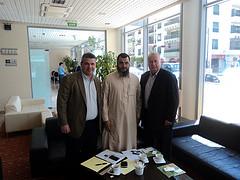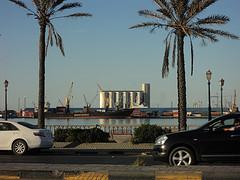By Cary Sifferath, USGC Senior Director in Tunisia
During a recent mission to Libya with the American Soybean Association and the U.S. Wheat Associates, we uncovered a major untapped ruminant market with potential for new U.S. sales of distillers dried grains with solubles (DDGS). In addition, the Libyan poultry industry is slowly recovering after the revolutionary upheavals of the last year.
In the post-revolutionary climate, the Libyan feed, poultry, and livestock industries also have new opportunities to grow, invest, and seek out foreign partnerships. Libya’s oil exports are back to 95% of pre-revolutionary levels, and the country’s oil and natural gas wealth undergird a relatively strong economy. Adding it up, Libya has renewed potential for U.S. exporters despite its small population of about six million.
Prior to the revolution, Libya annually imported between 450,000 to 650,000 metric tons (18 to 26 million bushels) of corn in the 2005-2010 period. As a result of the recent upheavals, imports slowed in 2011 to approximately 320,000 tons (13 million bushels). This year, corn imports are likely to total roughly 450,000 tons (18 million bushels) as the country’s and feed/livestock industries rebound and rebuild.
During the 2007/2008 marketing year, there was a high of 243,000 tons (10 million bushels) of U.S. corn exports to Libya. U.S. corn in Libya competes with imported feed wheat, corn from other sources, and both domestic and imported barley for ruminant feed (sheep, cattle, camels). Imported soybean meal is also a factor; soybean meal imports ranged from 180,000 to 215,000 tons in the 2005 to 2010 period. Again, there was a major slowdown in 2011 due to the revolution, but the market is expected to pick up to 275,000 tons in 2012.
Buyer education and a leveling of the playing field can yield dividends in Libya. My trip was part of a US Ag Trade Mission that included colleagues from ASA and USW as well as companies representing U.S. poultry and beef exports, rice exports and equipment companies. We met with Libya’s Ministry of Agriculture and had one-on-one meetings with various Libyan companies. Among the issues discussed was Libya’s regulatory requirement of a non-GMO certification upon import of corn and soybean meal into Libya.
Despite this regulation, however, the Libyans often buy soybean and corn that contain GM events. What happens is that the major international trading companies sell corn and soybean meal sourced from a number of countries to EU, Tunisian, Egyptian or other brokers, who then resell into Libya. Some type of non-GM documentation is provided, and the shipment clears Libyan customs. Unfortunately, most observers (including Libyan importers) agree that several U.S. competitors are less than scrupulous in certifying their product, while the U.S. system is relatively transparent and reliable. A level playing field and even-handed enforcement of the rules would benefit U.S. exporters.
On a related note, the Libyan Ministry of Agriculture is coming to understand that part of the problem is that Libyan importers go through brokers to import these products, rather than buying directly from the exporter. We explained the Council’s programs to educate importers on how to source grain directly. This would increase transparency and provide a cost savings to Libyan importers and consumers.
The Libyan trip was well-timed for purposes of follow up. The Council has planned a DDGS information day in Tunis for both Tunisian and Libyan buyers on May 31, in partnership with Mirasco, POET and a Tunisian broker. While in Tripoli, I was able to meet several of the people that will attend the event, and thus have already made the first introduction of the Council, U.S. corn, barley, sorghum and DDGS.
There is potential in Libya, and the private ag industry in Libya is ready to grow. They are looking for assistance and would love to have U.S. companies come and invest in Libyan production agriculture. The Council is working to educate Libyan buyers on DDGS (no exports to speak of in the past) and to link Libyan buyers to U.S. feed grain and DDGS suppliers.
Click here for more photos.



